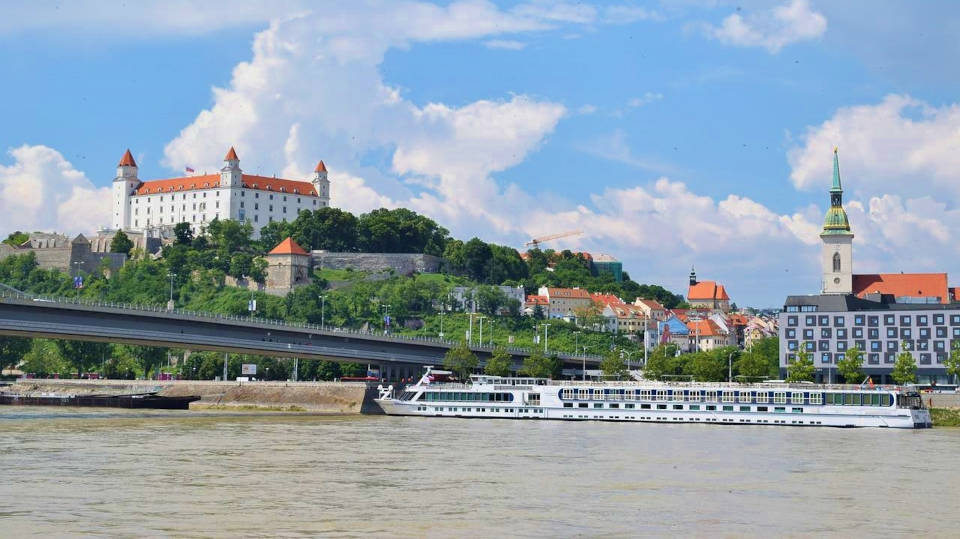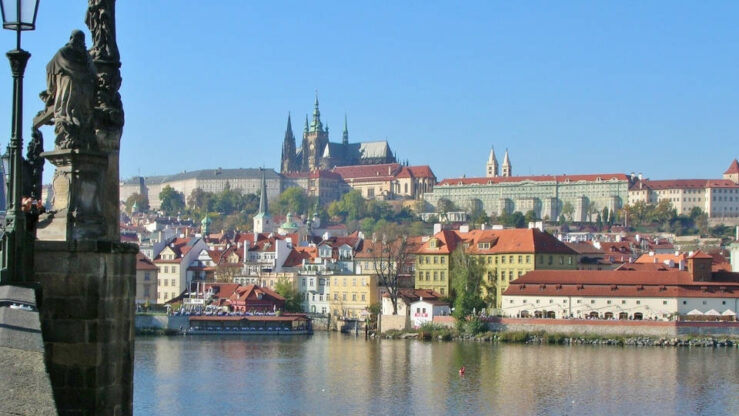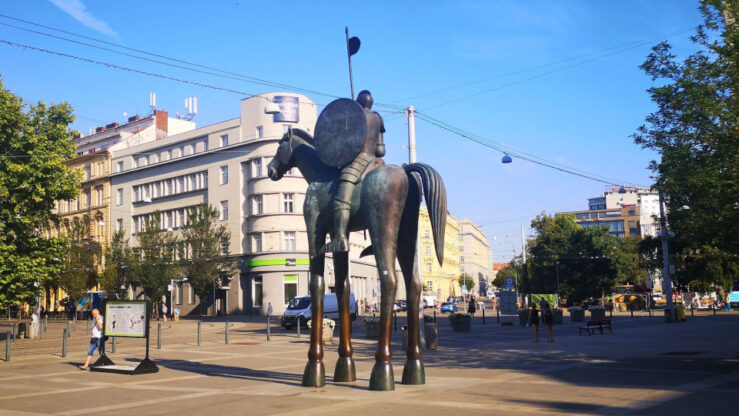Day trip Vienna to Bratislava, Capital of Slovakia – by Train, Bus or Boat
Day trip from Vienna to Bratislava
Bratislava Itinerary:
1. Bratislava Castle
2. Old Town Hall
3. Statues
4. Primate’s Palace
5. Slovak Pub
6. Blue Church
7. St Martin’s Cathedral
Bratislava in Slovakia (formerly also known as Pressburg, Pozsony and Prespork) is close to three borders: the Austrian, the Hungarian, and a little bit further away from the border of the Czech Republic. Over the years, it has thus been influenced by several nations. The city was the capital and coronation city of Hungary for nearly 300 years, during the era of the Hungarian Kingdom. Likewise, Bratislava has always been closely related to its Austrian counterpart, Vienna, and there are several similarities between the two cities. Due to its cultural heritage and multifaceted history, Bratislava, the current capital of Slovakia, is a fascinating city to visit and explore on a day trip from Vienna – which is perfectly possible by car, train, bus or boat.
Although the capital of Slovakia, Bratislava is a smaller European city with a population of less than half a million people, located near Vienna. For centuries, the two cities have been closely related. When visiting Vienna, it is straightforward to benefit from the short distance to make a day tour to Bratislava in Slovakia on the same trip.
Because of Bratislava’s limited extent, it is possible to cover all the highlights in one day – provided that you don’t intend to see all the palaces from the inside! You can leave Vienna in the morning for Slovakia – and return in the evening after a full day of sightseeing in Bratislava. You may also include the night before or after in Bratislava to experience the city by night.
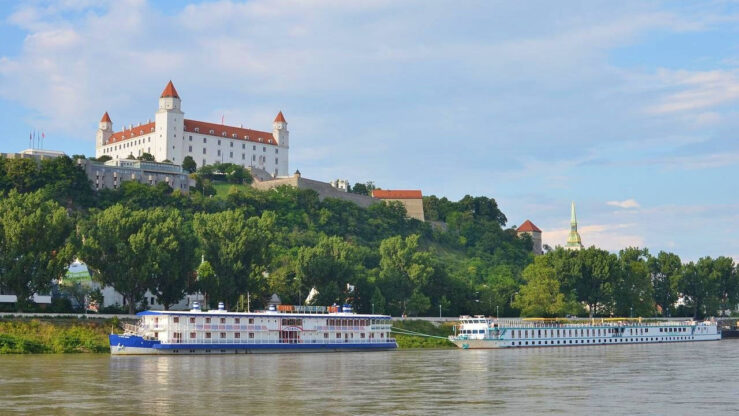
Photo: Odovolenkesk / Pixabay
There are several possibilities when deciding how to travel between Vienna and Bratislava in Slovakia.
You can go by train, bus, car or boat on a cruise from Vienna. It is possible to leave from Vienna in the morning and arrive in Bratislava within an hour and a half – and maybe less – depending on the chosen means of transport. Likewise, you can take the return trip in the late afternoon or evening – unless you prefer to stay until the next day to take advantage of a night in the capital of Slovakia!
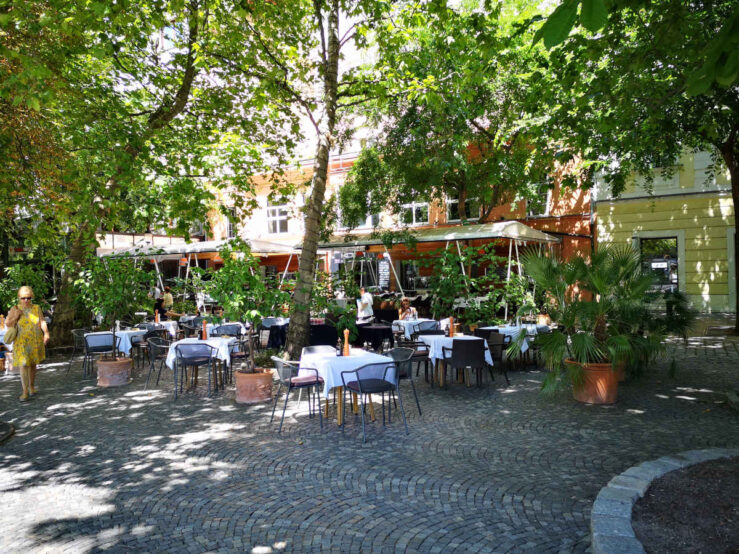
Photo: Travel In Culture
The fastest way to go from Vienna to Bratislava is by car, bus or train, where it takes up to 90 minutes to Slovakia by boat with the Twin City Liner (75 minutes from Vienna to Bratislava down the Danube, and 90 minutes return from Slovakia to Vienna). The catamaran is a convenient way to travel between Vienna and Bratislava, and the river cruise offers seat categories from economy class to first class on the boat.
Going from Vienna to Bratislava by car, bus, or coach takes from 45 minutes and is a more budget-friendly option. The train journey between the two cities takes slightly more than one hour in comparison. Depending on the way you choose to go, the journey between the two capitals can be done in about an hour, so it is relatively easy to do Bratislava as a day trip from Vienna – whether by train, bus or boat.
The suggested 1-day itinerary below will take you past all the top sights in the centre of Bratislava (on foot).
After arriving, the first thing on your agenda will be to walk up to Bratislava Castle. The castle is atop a hill from where the city and the Danube are magnificent sights to behold.
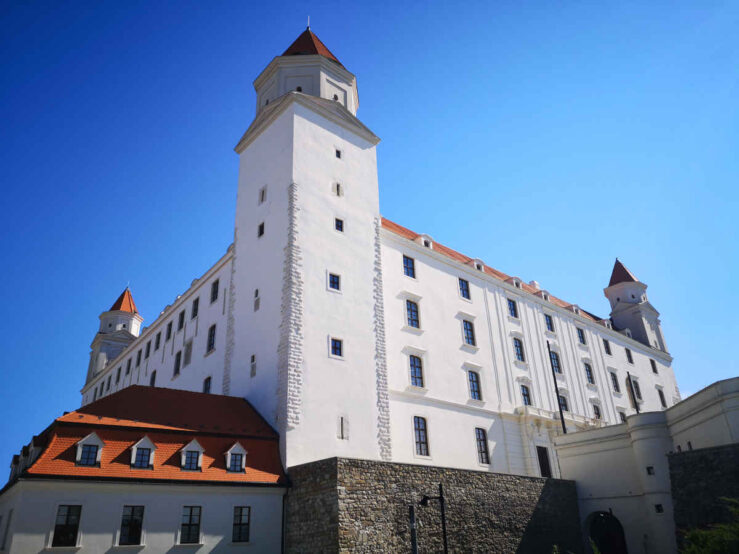
Photo: Travel In Culture
Since medieval times – and even before when the Celts settled here – there has been a fortress above Bratislava to protect the city. Over the years, it has gradually been transformed into the imposing construction that today overlooks the capital of Slovakia. You will detect elements of the Gothic, baroque and Renaissance styles in the massive building, rebuilt under Maria Theresa in the 18th century, and recently reconstructed in the mid-20th century.
In the past, the coronation jewels (from the time Bratislava was the capital of Hungary) used to be stored inside the Crown Tower. Today, the castle houses the Museum of History.
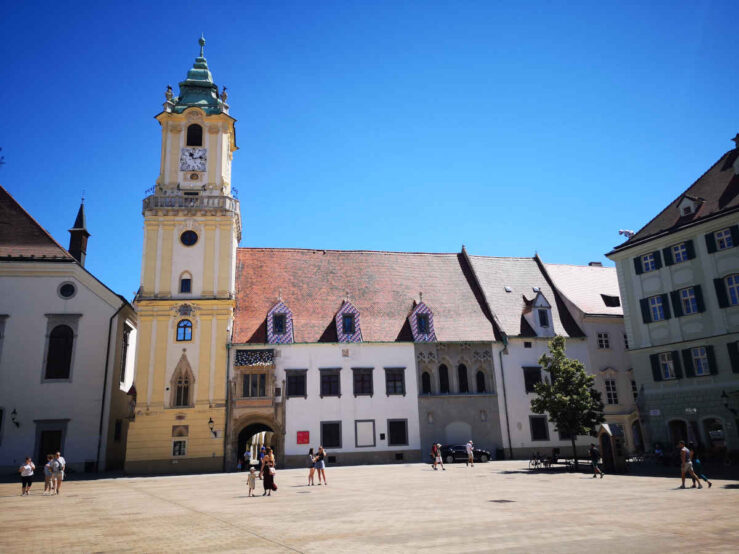
Photo: Travel In Culture
Once down again, you will stroll over to the Main Square (Hlavné námestie) and the streets surrounding the Old Town Hall, an amazing building composed of sections in various architectural styles. Renaissance, baroque and neo-Gothic styles are represented in the later structures. In the 14th century, the oldest Gothic part served as the town hall. Years later, the building was chosen as the ideal location and setting for the local prison!
Today, the beautiful edifice flanking the Main Square is still a popular sight in the city, and it now houses the Bratislava City Museum.
Nearby, you will find the Slovak National Theatre, a neo-Renaissance building by the Viennese architects F. Fellner and H. Helmer, dating from 1886, where the City Theatre performed.
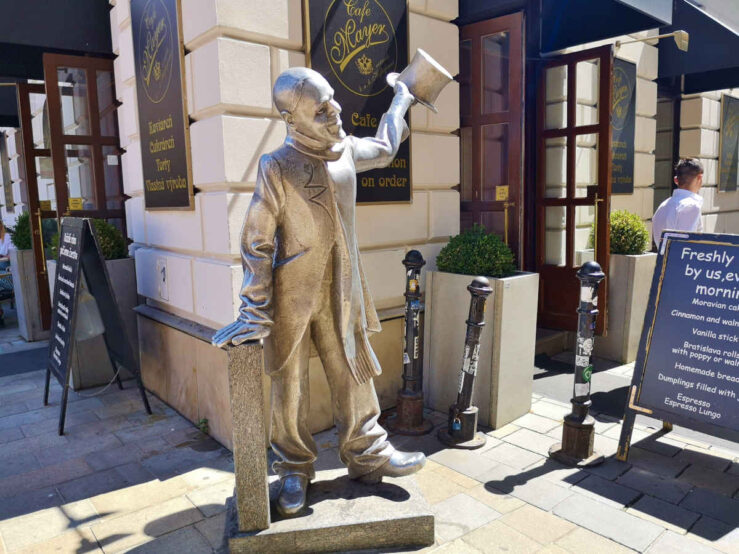
Statue of a true gentleman | Photo: Travel In Culture
Scattered around the city are Bratislava’s renowned statues. In the Main Square, you will probably already have spotted one of Napoleon’s soldiers leaning on a bench, an artwork by Juraj Melis depicting Napoleon’s army visiting Slovakia and Bratislava in 1805 or 1809. Just around the corner, there is another iconic statue, the Schöner Náci statue representing the gentleman Ignác Lamár, also created by Juraj Melis.
Other famous statues in the city centre include the Hans Christian Andersen statue from 2006 erected by the Slovak sculptor Tibor Bártfay, as well as the today probably most eye-catching landmark and tourist attraction, Čumil, or Rubberneck, climbing up from a manhole in the bustling street amid pedestrians and other traffic. He was created in 1997 by Viktor Hulík and has been a popular attraction ever since.
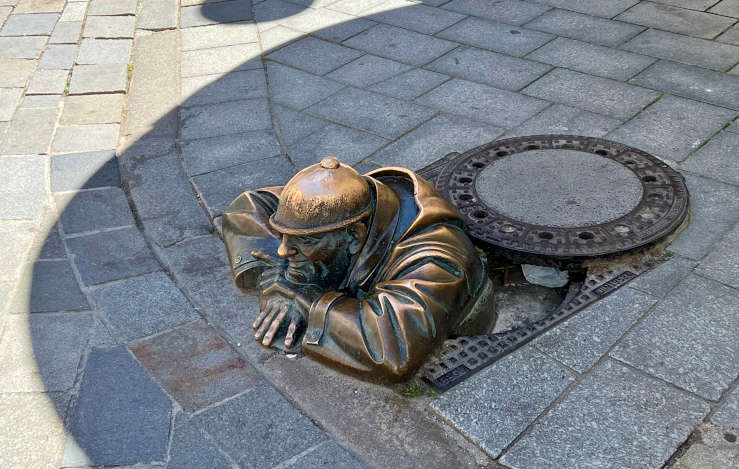
Čumil | Photo: Travel In Culture
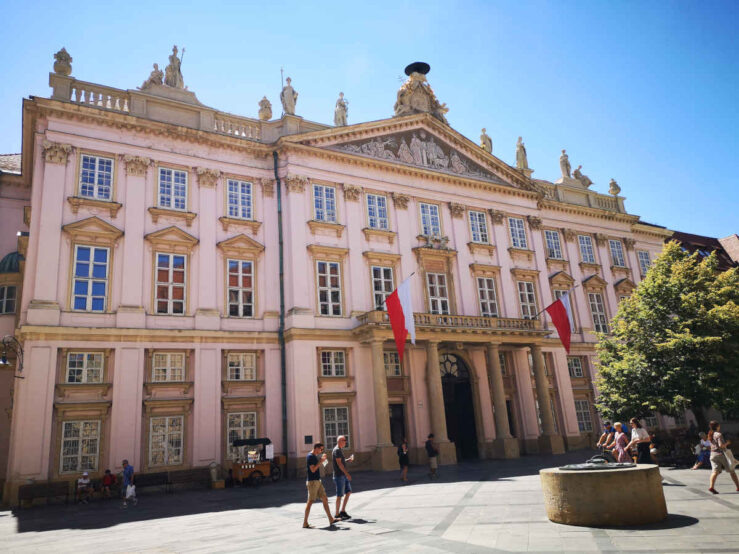
Photo: Travel In Culture
A stone’s throw away, you will arrive at the Baroque-classicist light pink candy-coloured Primate’s Palace, erected towards the end of the 18th century. The mansion is historic since its Mirror Hall was used for signing the Treaty of Pressburg in 1805, related to Napoleon’s victory in the Battle of Austerlitz.
In the past, the Primate’s Palace belonged to the Archbishop, and it is today an important cultural heritage. Besides the Mirror Hall, it is known for its spectacular St George’s Fountain in the courtyard and an outstanding collection of gobelins dating from the 17th century.
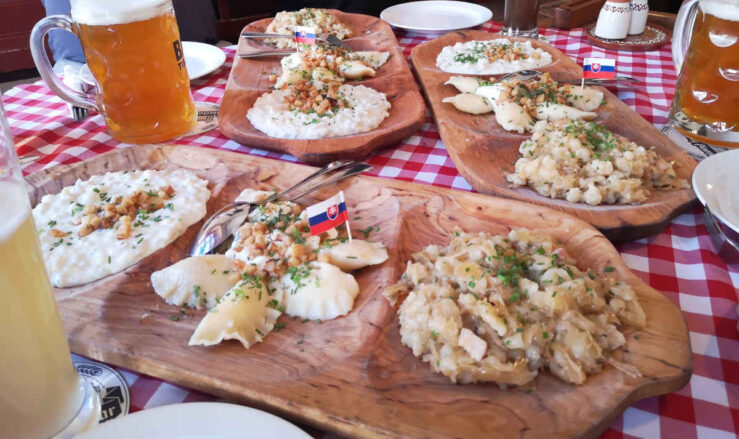
Food at the Slovak Pub | Photo: Travel In Culture
By now, it must be time for a Slovak meal. You can, for instance, head towards the Slovak Pub at 62 613, Obchodná.
On the way to the Slovak Pub, you can make a minor detour passing by the 13th-century Michael’s Gate which is a former city gate with a ‘zero-kilometre’ mark beneath the tower (maybe you will even climb the tower for magnificent views of Bratislava), the beautiful Old Cathedral of Saint John of Matha and Saint Felix of Valois, as well as the impressive rococo-baroque presidential palace, Grassalkovich Palace, that since the fall of the communist regime has been the seat of the Slovak president.
In the old Slovak Pub, tasty Slovak meals are served, and you can, for instance, try potato dumplings with Slovak bryndza sheep cheese, pirogi with bryndza, or dumplings with cabbage and bacon. Of course, you will be encouraged to try the local Slovak beer!
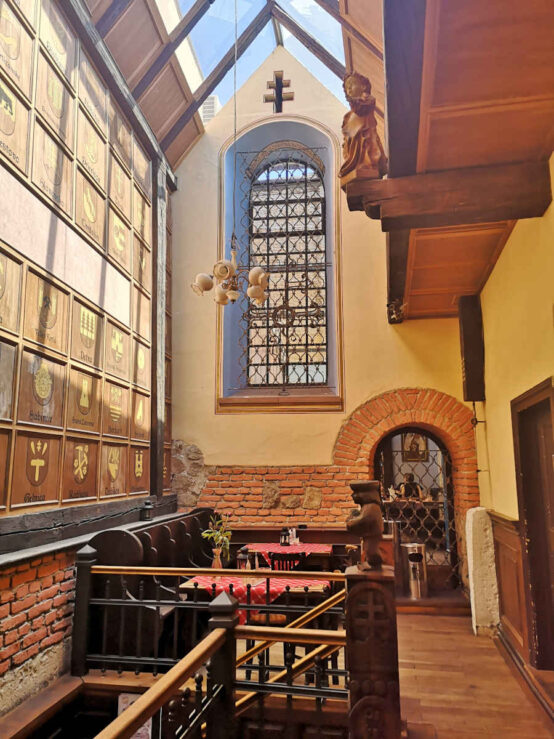
Slovak Pub | Photo: Travel In Culture
As for the setting, it speaks for itself – it is a very traditional pub, although with eight unusual rooms, each intended for distinct use and guests. One is originally for poets and writers (the Poets’ Room), another is dedicated to the intellectuals (Štúr’s Room) and so forth. It is all explained in the comprehensive menu, where also the bryndza is described together with the history of the pub. It is an excellent place to get a bit of Slovak culinary culture!
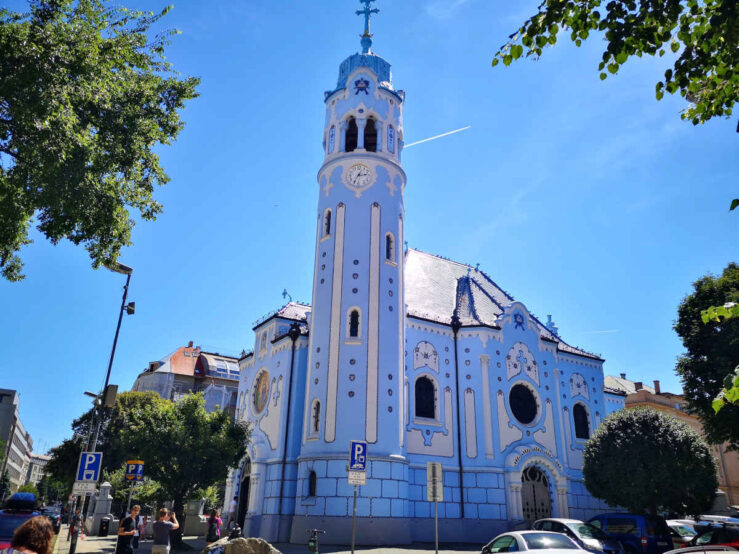
Photo: Travel In Culture
You will continue on foot to the Blue Church, one of numerous beautiful churches in Bratislava. Nevertheless, this one is particularly interesting due to its shades of blue inside and outside.
On the way, you can take the chance to see if the cubist Synagogue at Heydukova Street is open – it is the only remaining synagogue in Bratislava, and it is listed as a Slovak National Cultural Monument. The building also houses the Bratislava Jewish Community Museum.
The Blue Church is also known as St Elizabeth’s Church, and it is one of the most remarkable constructions in Bratislava that features the art nouveau style. Designed by the Hungarian architect Edmund Lechner, it was erected as no less than a high school chapel. Adjacent to the Blue Church, you will discover the fascinating school building in a similar noteworthy style. Not surprisingly, it was the very same architect who was responsible for the architectural design of that building.
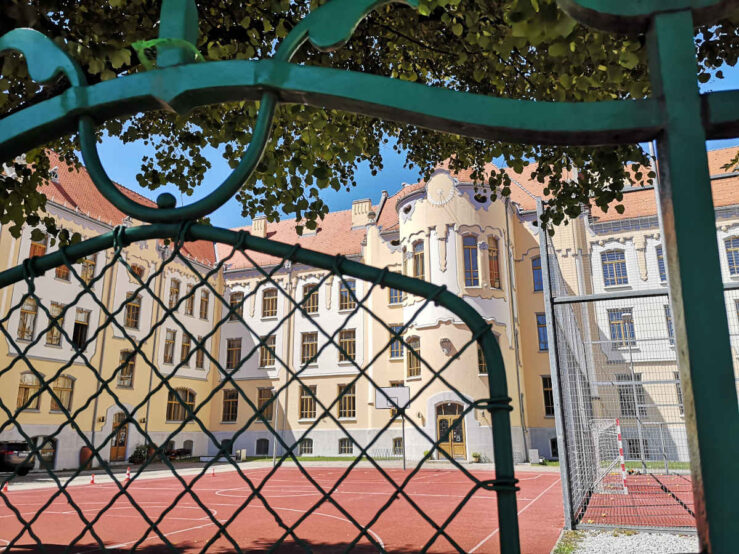
School next to the Blue Church by the same architect Edmund Lechner | Photo: Travel In Culture
After visiting the Blue Church, it is time for a stroll along the river with a view of the two bridges, the SNP / UFO Bridge with a ‘flying saucer’ restaurant on top (hence the nickname), as well as an observation deck, and the green Old Bridge where the trains pass the Danube. On the way down to the Old Bridge, you may catch a glimpse of Bratislava University and a plethora of fascinating house façades of architectural beauty from Bratislava’s former heyday.
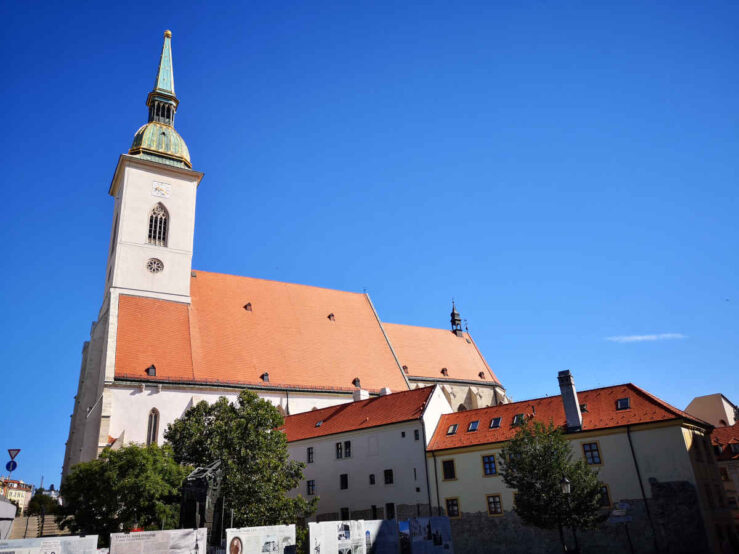
Photo: Travel In Culture
Finally, you will be back in the vibrant streets of the Old Town. That is also where you will discover one of the oldest streets in Bratislava, Kapitulská. Moreover, the old city wall is preserved here to some extent and forms part of the southern church wall of St Martin’s Cathedral!
The Cathedral is exceptional in appearance, with a gilded coronation crown on top of the cathedral tower (85 metres high – and quite an impressive part of the city skyline). It symbolises the coronation events occurring between 1563 and 1830, where 18 Hungarian monarchs were crowned inside the Cathedral, one being Queen Maria Theresa. At that time (before being the capital of Slovakia), Bratislava had capital status in the former Hungarian Kingdom. Another interesting feature of the Cathedral is the underground crypt with catacombs.
After completing the suggested itinerary, you will now either return to Vienna – or maybe opt to stay in Bratislava for the night to enjoy dinner in another local Slovak restaurant – and experience Bratislava’s thriving nightlife, as well as the fascinating nocturnal views of the city and river.
Read next: Visit Brno or Prague? and Discover the Top Sights of Prague
Day trip Vienna to Bratislava, Capital of Slovakia – by Train, Bus or Boat
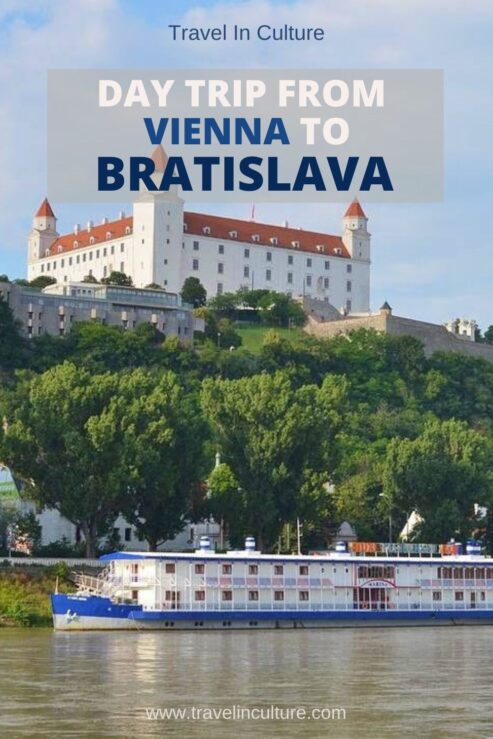
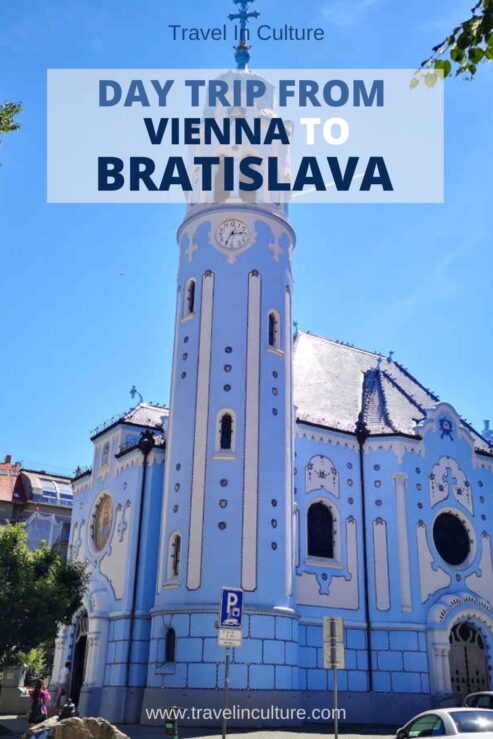
Featured image of
Day trip Vienna to Bratislava, Capital of Slovakia, by Train, Bus or Boat:
Mirijah / Pixabay
Day trip Vienna-Bratislava by train


